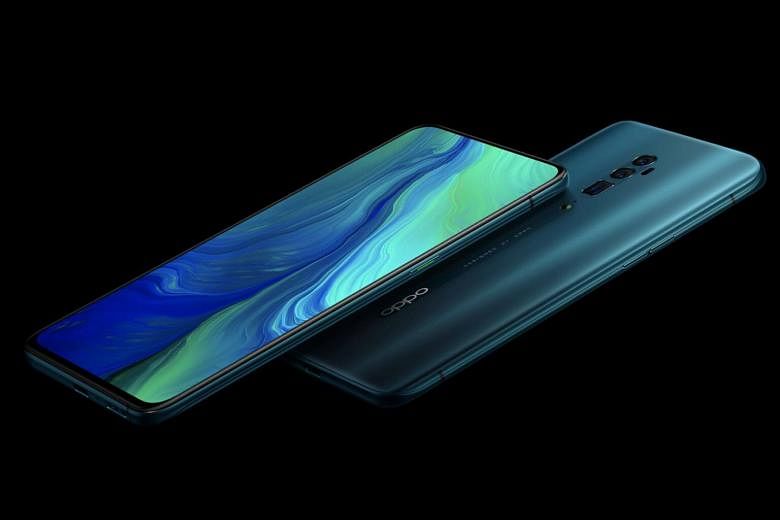What a difference a few months make. In April, Huawei was riding high on the back of glowing reviews for its P30 Pro smartphone.
Its camera, in particular, received plaudits for a periscope design that offers 5x optical zoom, up from 2x to 3x zoom on other phones.
Huawei was the first to sell a phone with this zoom feature, but the camera technology comes from an Israeli firm, which has also licensed it to another smartphone-maker, Oppo.
Hence, a similar periscope-style telephoto camera is found in the Oppo Reno 10x Zoom, which made its local debut last week. The timing of its launch could not have been better for Oppo, with the United States-China trade tiff casting a pall over Huawei smartphones.
While the Reno offers 5x optical zoom, its camera app comes with wide-angle, 2x, 6x and 10x presets that you tap to cycle through. You can also move a slider to get the desired amount of zoom, up to 60x.
At 60x zoom (10x more than the maximum of the Huawei P30 Pro), the camera shakes so much that it is impossible to get a decent photo. But it has useful moments, such as capturing faraway text or details that cannot be discerned by the human eye.
At 10x zoom, I found the photos taken with the Oppo to be a tad brighter than those taken with the Huawei. Both produce photos with good detail and colour, albeit with a hint of softness.
-
FOR
- Top-class zoom performance
- Surprisingly good haptics
- Runs cool in games and apps
AGAINST
- Hefty and large
- No waterproofing due to pop-up camera
SPECS
Price: $1,199
Processor: Qualcomm Snapdragon 855 (Single-core 2.8GHz, triple-core 2.4GHz and quad-core 1.8GHz)
Display: 6.6-inch, Oled, 2,340 x 1,080 pixels, 387 ppi pixel density
Operating system: ColorOS 6 (Android 9.0)
Memory: 256GB (microSD expandable up to 256GB), 8GB RAM
Rear cameras: 48MP (f/1.7), 8MP ultra-wide-angle (f/2.2), 13MP telephoto (f/3.0)
Front camera: 16MP (f/2.0)
Battery: Non-removable 4,065mAh battery
RATING
Features: 4/5
Design: 4/5
Performance: 4.5/5
Value for money: 4/5
Battery life: 4/5
Overall: 4/5
Besides the telephoto camera, the Reno has a 48-megapixel (MP) primary camera and an 8MP wideangle (120 degrees) camera. It is the same 48MP Sony image sensor as the ones on the Xiaomi Mi 9 and Honor View20.
By default, this camera uses all the visual information captured by its 48MP sensor to produce sharp 12MP photos with plenty of details and little noise. You can manually switch to 48MP in the settings.
The camera app offers a useful Ultra Night mode for low-light photography. Photos taken at night with street lighting are noticeably brighter using this mode. But the Reno cannot match the extreme low-light performance of the Google Pixel 3 and the Huawei P30 Pro. The Reno's camera is unusable in a nearly pitch-dark room.
All three rear cameras are flush with the phone's glass back. There is no unsightly camera bump, but the Reno is on the thick side. It is also fairly hefty at 215g, though the curved back sits comfortably in my hand.
Part of the reason for its weight - besides a large 4,065mAh battery - is a 6.6-inch, 1080p Oled screen that is bright with good contrast.
More importantly, this display does not have a camera notch and is surrounded by slim bezels all round, which makes for an excellent full-screen viewing experience while watching videos.
What about the selfie camera? Well, it emerges from the top of the phone at an angle, like a shark's fin.
Like the mechanised pop-up camera in last year's Find X phone, the Reno's front camera instantly retracts into the chassis when dropped to avoid being damaged. But this selfie camera design means the Reno is not waterproof and dust gets into the gaps between the camera module and the phone's body.
The Reno has one of the fastest in-display fingerprint sensors I have tried. And it rarely gets it wrong too. It also feels fast in apps and general use, thanks to flagship hardware such as a high-end Qualcomm Snapdragon 855 processor and 8GB of memory.
A copper heat pipe keeps the processor cool, even while running mobile games such as PUBG Mobile at the highest graphics setting.
An often understated part of the smartphone experience is the haptic feedback from the phone's vibration motor. Typing on the Reno's virtual keyboard felt great as each key gave a tight focused vibration when tapped. It is arguably as good as that of the Google Pixel 3, which is one of the best among Android phones.
Based on the Android 9 operating system, Oppo's ColorOS 6 user interface borrows a number of features from others to add to its own, so users have more choices.
Take, for example, gesture navigation. It incorporates the gestures found in Huawei and Xiaomi phones, which you can switch to if you dislike Oppo's implementation.
Overall, ColorOS looks and feels like an amalgamation of ideas and features from other smartphones.
Battery life is good enough, with the Reno typically lasting just over a day. In a video-loop battery test, it lasted 12hr 43min, which is reasonable for its screen size.
The phone does not offer wireless charging, but its battery charges rapidly with the wired charger that is included, going from 27 per cent to 70 per cent in just half an hour.


